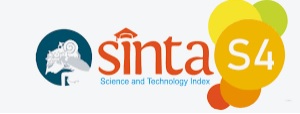Analisis Usability Sistem Permohonan Legalisir Menggunakan Metode System Usability Scale
Abstract
One of the applications of e-Government in the districts is the application for legalization of documents that can be accessed widely. Since it was implemented, the application has never been evaluated for usability. So that the ease of use of the application can not be determined. The study measures the usability of quantitative applications using the System Usability Scale (SUS) method using a 10-item rating scale. Based on the test results, the usability value of general public application users has a "Good" value for an adjective rating and has a "D" scale for a grade scale. Meanwhile, the acceptability ranges are at a "High-Marginal" value. Then the usability value of the agency user gets the value "Good" for the adjective rating and has a "C" scale for the grade scale. The acceptability ranges are at a "High-Marginal" value. Aspects that are important to note for improvement or further application development are the aspects of errors and aspects of satisfaction.
Keyword: Analisys; Satisfaction; Errors; User experience
Â
Abstrak
Salah satu penerapan e-Goverment di kantor kecamatan adalah aplikasi permohonan legalisir dokumen yang dapat diakses secara luas. Sejak diimplementasikan, aplikasi belum pernah dilakukan evaluasi usability. Sehingga belum dapat dipastikan kemudahan penggunaan aplikasi oleh pengguna. Penelitian mengukur usability terhadap aplikasi kuantitatif menggunakan metode System Usability Scale (SUS) menggunakan 10 item skala penilaian. Berdasarkan hasil pengujian, nilai usability pengguna aplikasi masyarakat umum memiliki nilai Good untuk adjective rating dan memiliki skala “D†untuk grade scale. Sedangkan pada acceptability ranges berada pada nilai High-Marginal. Kemudian nilai usability pengguna instansi didapatkan nilai Good untuk adjective rating dan memiliki skala “C†untuk grade scale. Pada acceptability ranges berada pada nilai High-Marginal. Aspek yang penting untuk diperhatikan untuk perbaikan atau pengembangan aplikasi lebih lanjut adalah aspek errors dan aspek satisfaction.
Â
Keywords
References
J. D. Twizeyimana dan A. Andersson, “The public value of E-Government – A literature review,†Government Information Quarterly, vol. 36, no. 2, p. 167, 2019.
W. Ariannor dan S. Abidah, “Evaluasi User Experience Sistem E-Learning Evaluasi User Experience Sistem E-Learning,†Jutisi: Jurnal Ilmiah Teknik Informatika dan Sistem Informasi, vol. 11, no. 2, pp. 383-392, 2022.
T. Wahyuningrum, “Perbedaan UI, UX dan Usability: tenia.dosen.ittelkom-pwt.ac.id,†IT Telkom Purwokerto, 29 September 2019. [Online]. Available: https://tenia.dosen.ittelkom-pwt.ac.id/2019/09/29/perbedaan-ui-ux-dan-usability/. [Diakses 19 Januari 2023].
T. Wahyuningrum, Buku Referensi Mengukur Usability Perangkat Lunak, Yogyakarta: Deepublish, 2021.
A. Revythi dan N. Tselios, “Extension of Technology Acceptance Model by Using System Usability Scale to Assess Behavioral Intention to Use E-Learning,†Education and Information Technologies, vol. 24, no. 4, pp. 2341-2355, 2019.
T. Wahyuningrum, C. Kartiko and A. C. Wardhana, "Exploring e-Commerce Usability by Heuristic Evaluation as a Compelement of System Usability Scale," in 2020 International Conference on Advancement in Data Science, E-learning and Information Systems (ICADEIS), Lombok, 2020.
A. R. Firdaus, N. H. Wardani dan L. Fanani, “Evaluasi dan Rekomendasi Perbaikan Usability pada System Autoworksys pada PT. Prima Berkat Gemilang dengan menggunakan Metode Heuristic dan System Usability Scale (SUS),†Jurnal Pengembangan Teknologi Informasi dan Ilmu Komputer, vol. 3, no. 6, pp. 5799-5807, 2019.
N. A. Wulandari, S. Rohman, N. Nulngafan dan H. Hermawan, “ANALISIS USABILITY APLIKASI RSI WONOSOBO MENGGUNAKAN METODE SUS (SYSTEM USABILITY SCALLE),†STORAGE – Jurnal Ilmiah Teknik dan Ilmu Komputer, vol. 1, no. 3, pp. 20-25, 2022.
R. Widayanti dan J. Maknunah, “Analisis Website STIMATA Menggunakan System Usability Scale (SUS),†Jurnal Ilmiah KOMPUTASI, vol. 20, no. 3, pp. 331-338, 2021.
K. Zainurrohmah, D. Y. Kristiyanto dan D. Darmansah, “Evaluasi Usability Website Sistem Informasi Pelayanan Perizinan Banyumas (SIPANJIMAS) Menggunakan Metode System Usability Scale (SUS),†Jurnal Sistem Komputer dan Informatika (JSON), vol. 3, no. 4, pp. 510-515, 2022.
A. H. Muhammad and I. K. G. Suhartana, "Analisis Usability Testing pada Website Desa Petandakan," in Prosiding Seminar Nasional Universitas Ma Chung, Malang, 2022.
Y. Arifin, “Article: KENAL DEKAT dengan USABILITY TESTING,†BINA NUSANTARA School of Computer Science, 9 Agustus 2018. [Online]. Available: https://socs.binus.ac.id/2018/08/09/kenal-dekat-dengan-usability-testing/. [Diakses 18 Januari 2023].
W. N. Fathoni dan M. Maryam, “Rancang Bangun Sistem Informasi Pelayanan Surat Keterangan Berbasis Web,†Jurnal Pendidikan dan Teknologi Indonesia (JPTI), vol. 1, no. 5, pp. 199-208, 2021.
M. Yusuf dan Y. Astuti, “Analisis dan Evaluasi Aspek Usability pada Aplikasi Pijar Career Center Menggunakan System Usability Scale (SUS),†Komputika: Jurnal Sistem Komputer, vol. 9, no. 2, pp. 131-138, 2020.
Z. Sharfina and H. B. Santoso, "An Indonesian adaptation of the System Usability Scale (SUS)," in 8th International Conference on Advanced Computer Science and Information Systems, ICACSIS 2016, Malang, 2016.
Z. Miftah dan I. P. Sari, “ANALISIS SISTEM PEMBELAJARAN DARING MENGGUNAKAN METODE SUS,†Research and Development Journal of Education, vol. 1, no. 1, pp. 40-48, 2020.
J. Brooke, “SUS: a retrospective,†Journal of Usability Studies, vol. 8, no. 2, pp. 29-40, 2013.
A. Saputra, “Penerapan Usability pada Aplikasi PENTAS Dengan Menggunakan Metode System Usability Scale (SUS),†JTIM : Jurnal Teknologi Informasi dan Multimedia, vol. 1, no. 3, pp. 206-212, 2019.
How To Cite This :
Refbacks
- There are currently no refbacks.











